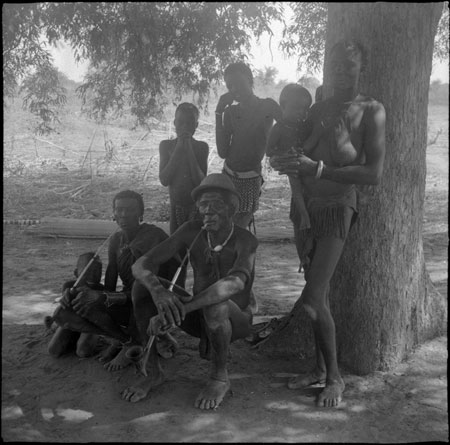Mandari group resting in shade

56 x 56 mm | Negative film nitrate
Date of Print:
Unknown
Previous PRM Number:
JB.5.6
Accession Number:
1998.97.155
Description:
A Mandari man, two women and several children resting in the shade of a tree.
The man and another woman are seated and smoking long pipes with clay bowls and stems with metal sections.
The other woman is holding a baby on her hip.
The older girls behind her are wearing chain-link aprons that were according to Buxton less common than in the past.
Photographer:
Jean Carlile Buxton
Date of Photo:
1950 - 1952
Region:
[Southern Sudan] Bahr el Jebel Tali
Group:
Mandari Dari
PRM Source:
Ronald Carlile Buxton via Institute of Social and Cultural Anthropology
Acquired:
Donated 1988
Other Owners:
Jean Buxton Collection
Class:
Social Life , Narcotic , Ornament
Keyword:
Pipe , Ornament Neck
Documentation:
See Related Documents File. Buxton field notebooks in Tylor Library.
Other Information:
In Some Notes on the Mandari of Equatoria Province, A.E.
Sudan, (typescript notebook of c.1951 in Tylor Library, Institute of Social and Cultural Anthropology, University of Oxford), book IV, page 31-32 Jean Buxton notes that 'Young girls up till about the age of 3 or 4 run about naked or with a little waist band of beads round the hips.
After that they all wear some kind of covering round the parts.
In the past the traditional Mandari dress was a small leather apron with a fringe, or a chain apron with a fringe of metal links suspended round the edge.
This is now generally replaced by small pieces of brown cloth tied round the loins...and several strings are often wound round the waist above the cloth.
These treasures are usually presents from male admirers...When a woman is married, she always wears a skin - usually that of a goat from which the hairs have been removed, and which is treated with fat to make it soft and pliable and is then coloured a rich rust brown with red ochre - tied round her waist so that it hangs down behind.
Nowadays this skin is beginning to be replaced with pieces of cloth, which in an older woman is often tied across the breasts.' [Chris Morton 3/11/2004]
Recorder:
Christopher Morton 15/2/2005 [Southern Sudan Project]

